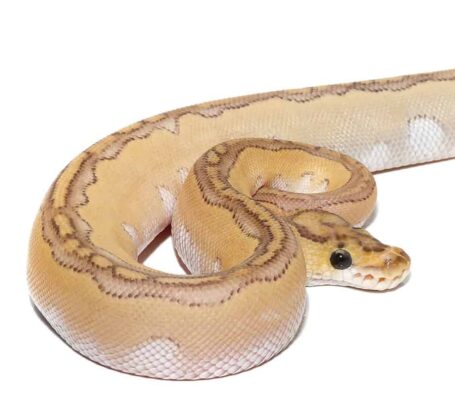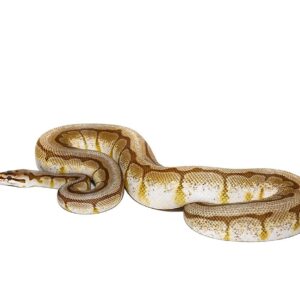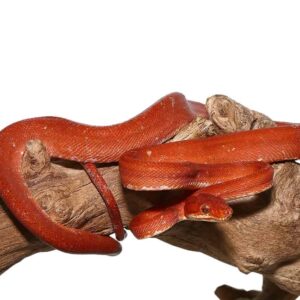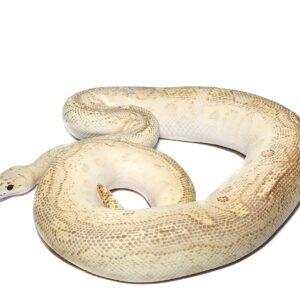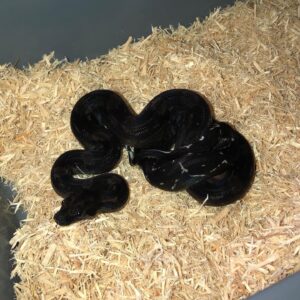Pastel Lesser Blade Clown Ball Python For Sale
$1,499.99
WE HAVE Pastel Lesser Blade Clown Ball Python FOR SALE. HERE ARE SOME HIGHLIGHTS:
- Python regius
- Captive Bred
- Female
- Approximately 19 Inches In Length
- Roughly 84 Grams And Growing
- When Hatching Out Of The Egg They Can Be As Small As 10 Inches And Grow To Be 5 Feet
- Feeding On Live Hopper Mice Weekly
FUN FACTS!
- Ball Pythons Are Native To Central And Western Africa And Thrive In These Warm, Tropical Areas
- These Snakes Are Brilliantly Colored With Gold’s, Browns, And Black Patterns From Head To Tail
- With Proper Care And Setup These Snakes Can Live 20 – 25 Years In Captivity
- Great For A First Time Keeper As Well As An Experienced Breeder
Description
The Pastel Lesser Blade Clown Ball Python is a captivating and unique morph that has garnered significant attention among reptile enthusiasts. This morph is the result of the intricate combination of four distinct genes: Pastel, Lesser, Blade, and Clown. Each of these genes contributes specific traits that, when combined, create the stunning appearance and desirable characteristics of this particular ball python.
The Pastel gene is known for enhancing the brightness and intensity of the snake’s coloration, often resulting in vibrant yellow hues. The Lesser gene, on the other hand, is responsible for a reduction in the snake’s pattern, giving it a more uniform and cleaner appearance. The Blade gene further refines this effect by minimizing the overall pattern, creating a sleek and streamlined look. Finally, the Clown gene introduces a distinctive pattern that includes bold, dark markings and a lighter background, culminating in a visually striking morph.
The history of the Pastel Lesser Blade Clown Ball Python can be traced back to the selective breeding practices within the reptile community. Breeders have meticulously combined these genes to produce a morph that stands out not only for its aesthetic appeal but also for its genetic complexity. This morph is highly sought after due to its unique appearance and the rarity of its genetic combination. Enthusiasts and breeders alike value the Pastel Lesser Blade Clown Ball Python for its vibrant colors, reduced pattern, and distinctive markings, making it a prized addition to any collection.
In summary, the Pastel Lesser Blade Clown Ball Python is more than just a visually appealing snake; it represents the culmination of careful genetic selection and breeding. Its unique blend of Pastel, Lesser, Blade, and Clown genes creates a morph that is both rare and highly coveted in the world of reptile enthusiasts.
Genetics and Morphology
The Pastel Lesser Blade Clown Ball Python is a captivating result of intricate genetic interplay. At its core, this morph is defined by the combination of four distinct genes: Pastel, Lesser, Blade, and Clown. Each gene contributes unique attributes that collectively shape the snake’s remarkable appearance.
The Pastel gene is known for its ability to enhance brightness and contrast in coloration. When present, it typically lightens the overall hue of the python, adding a vibrant yellow tone that makes the snake visually striking. This gene also accentuates the clarity of patterns, making them more pronounced.
The Lesser gene, on the other hand, has a diluting effect on pigmentation. It transforms the darker pigments into softer, more muted shades. When combined with the Pastel gene, the result is a beautifully balanced spectrum of colors, creating a visually appealing gradient that enhances the snake’s aesthetic appeal.
The Blade gene is instrumental in refining the pattern of the snake. It reduces the presence of busy, intricate markings, leading to smoother and cleaner patterns. This gene’s influence results in a more streamlined appearance, allowing the striking colors from the Pastel and Lesser genes to stand out more prominently.
Finally, the Clown gene is what truly sets this morph apart. As a recessive gene, it requires two copies to manifest its full potential. The Clown gene is responsible for creating the bold, contrasting patterns that are synonymous with the Clown morph. It introduces distinctive head markings and a pattern that dances along the snake’s body, making it a focal point of visual interest.
When these four genes interact, the outcome is the Pastel Lesser Blade Clown Ball Python. This morph showcases a harmonious blend of vibrant colors, muted tones, and clean, striking patterns. The interplay among these genes not only defines the snake’s physical characteristics but also underscores the complexity and beauty inherent in reptile genetics. Through careful breeding and an understanding of these genetic traits, enthusiasts can appreciate the marvel that is the Pastel Lesser Blade Clown Ball Python.
Habitat and Natural Behavior
The Pastel Lesser Blade Clown Ball Python, like all ball pythons, is native to the diverse landscapes of West and Central Africa. These regions offer a variety of habitats, ranging from open savannas and grasslands to forested areas. The climate in these areas is typically warm and tropical, with distinct wet and dry seasons. Temperatures generally range from 75°F to 90°F (24°C to 32°C), creating an ideal environment for these reptiles to thrive.
In their natural habitat, ball pythons are known to seek out cover in numerous hiding spots. They are often found in burrows abandoned by other animals, under logs, or within dense vegetation. These hiding spots provide them with protection from predators and harsh environmental conditions. This preference for secluded spaces is also observed in captivity, where providing adequate hiding places is essential for their well-being.
Ball pythons are primarily nocturnal creatures, meaning they are most active during the night. This nocturnal nature aids them in avoiding the heat of the day and reduces the risk of encountering potential threats. During the night, they emerge to hunt for food, primarily preying on small mammals such as rodents. Their hunting strategy involves ambushing their prey, using their keen sense of smell and heat-sensing pits to locate and capture their meals.
In captivity, the Pastel Lesser Blade Clown Ball Python retains much of its natural behavior. Owners often notice their pet’s preference for hiding during the day and increased activity during the night. Providing an environment that mimics their natural habitat, with appropriate hiding spots and temperature gradients, is crucial to ensuring their comfort and health. Understanding these behaviors and habitat requirements allows keepers to create a more enriching and supportive environment for their ball pythons.
Housing and Environmental Needs
Proper housing is crucial for maintaining the health and well-being of a Pastel Lesser Blade Clown Ball Python. The ideal enclosure should be spacious enough to allow for natural movement and exploration. A 20-gallon tank is a minimum requirement for juveniles, while adults typically necessitate a 40-gallon tank or larger. Ensuring that the enclosure is secure is vital, as ball pythons are adept escape artists.
Temperature regulation is a critical aspect of the enclosure. A temperature gradient should be established, with a warm side maintained at 88-92°F and a cooler side at 78-82°F. This gradient allows the python to thermoregulate by moving between different temperature zones. Utilizing a reliable thermostat and heat sources, such as under-tank heaters or ceramic heat emitters, is recommended to maintain these conditions. Nighttime temperatures can safely drop to around 75°F without causing harm to the snake.
Humidity levels are equally important, with an optimal range of 50-60% to support healthy shedding and respiratory function. This can be achieved by regular misting, using a hygrometer for monitoring, and incorporating a water bowl large enough for the snake to soak in. Substrate choices should facilitate humidity retention; options include cypress mulch, coconut husk, or aspen bedding. Each of these substrates has its own benefits, but they should be spot-cleaned regularly and completely replaced every few months to prevent bacterial growth.
Creating a naturalistic environment with hiding spots is essential for reducing stress and replicating the Pastel Lesser Blade Clown Ball Python’s natural habitat. Hides should be placed on both the warm and cool sides of the enclosure. Additionally, providing branches, rocks, and other forms of enrichment can stimulate natural behaviors and offer mental engagement. These elements not only enhance the physical environment but also contribute to the overall well-being of the python.
Diet and Feeding Habits
The dietary needs of the Pastel Lesser Blade Clown Ball Python are relatively straightforward but essential for its overall health and wellbeing. As a carnivorous species, this ball python primarily feeds on rodents, with mice and rats being the most appropriate choices. The size of the prey should be matched to the girth of the snake; typically, the prey should be no larger than the widest part of the snake’s body to ensure easy ingestion and digestion.
Feeding frequency varies with age. Juvenile Pastel Lesser Blade Clown Ball Pythons should be fed once every 5-7 days to support their rapid growth. As they mature, the feeding interval can be extended to once every 7-10 days. Adult pythons can be fed less frequently, approximately every 10-14 days, depending on their size and metabolism.
Ensuring proper nutrition involves more than just feeding the right prey. It’s advisable to offer a variety of prey sizes and types to prevent dietary monotony and ensure a balanced intake of nutrients. While live prey can be stimulating and encourage natural hunting behaviors, there are risks—including injury to the snake from a struggling rodent. Therefore, many keepers opt for pre-killed or frozen-thawed prey, which can be just as nutritious and safer for the snake.
Feeding issues, such as refusals, can occasionally arise. A common cause of refusal is stress, often due to inadequate enclosure conditions or handling. Ensuring optimal habitat conditions—such as appropriate temperature, humidity, and hiding spots—can mitigate stress and encourage feeding. If a snake refuses food, it is essential to check these environmental factors first. Additionally, some ball pythons are known to be picky eaters and may prefer specific prey types or feeding times. Observing and catering to these preferences can improve feeding success.
In conclusion, understanding and adhering to the dietary needs and feeding habits of the Pastel Lesser Blade Clown Ball Python is crucial for maintaining its health. By providing a varied diet, appropriate feeding frequency, and addressing any feeding issues promptly, keepers can ensure their python thrives in captivity.
Health and Common Issues
The Pastel Lesser Blade Clown Ball Python, like other ball python morphs, is generally a hardy species. However, they are not immune to health issues, and it is crucial for owners to be aware of common ailments to ensure their pet remains healthy. One of the most common health issues affecting these pythons is respiratory infections. These can arise due to poor enclosure conditions, such as inadequate humidity levels or improper temperatures. Signs of respiratory infections include wheezing, mucus around the nostrils, and open-mouth breathing. To prevent such infections, maintaining optimal humidity levels between 50-60% and keeping the enclosure temperature within the recommended range is essential. If you notice any symptoms, consulting a reptile veterinarian is advisable for proper diagnosis and treatment.
Mites are another prevalent issue that can affect the Pastel Lesser Blade Clown Ball Python. These tiny parasites can cause significant discomfort and stress to the snake. Mites often appear as small black or red dots and are usually found around the eyes, mouth, and under the scales. Regularly inspecting your python and its enclosure can help catch an infestation early. Treatment typically involves thorough cleaning of the enclosure and the use of reptile-safe mite treatments. Preventing mites involves maintaining a clean environment and quarantining new additions before introducing them to the main enclosure.
Improper shedding, or dysecdysis, is also a common problem, often linked to inadequate humidity levels. A healthy Pastel Lesser Blade Clown Ball Python should shed its skin in one complete piece. If you notice incomplete sheds or retained eyecaps, it is a sign that the humidity levels may be too low. Providing a humid hide or misting the enclosure can help facilitate proper shedding. Additionally, ensuring your python has access to rough surfaces can aid in the shedding process.
Recognizing signs of illness early, such as changes in appetite, lethargy, or unusual behavior, is vital. Regular health checks and a well-maintained environment are key to preventing most health issues. When in doubt, seeking advice from a veterinarian experienced with reptiles can ensure your Pastel Lesser Blade Clown Ball Python remains in optimal health.
Breeding and Reproduction
Breeding the Pastel Lesser Blade Clown Ball Python involves a carefully orchestrated process that begins with selecting compatible mates. It is essential to choose pythons with desirable traits and strong genetic backgrounds to ensure healthy offspring. The selection phase involves identifying pythons that exhibit the Pastel, Lesser, Blade, and Clown genes, as these will influence the appearance and quality of the hatchlings. Compatibility is not solely based on genetics but also on the health and temperament of the potential breeding pairs.
Once suitable mates are identified, the breeding season typically commences in the cooler months, as temperature fluctuations can stimulate reproductive behavior. Breeders often employ specific environmental conditions, such as temperature cycling and light adjustments, to mimic natural seasonal changes and encourage mating. During this period, multiple introductions may be necessary to ensure successful copulation, as the timing and willingness of both pythons play a crucial role.
After successful mating, the female will undergo a gestation period, followed by oviposition, where she lays fertilized eggs. The clutch size can vary, usually ranging from 4 to 10 eggs. These eggs require meticulous care to ensure viable hatchlings. Incubation conditions are critical; maintaining a consistent temperature between 88-90°F and high humidity levels is paramount. Incubation typically lasts around 55 to 60 days.
Upon hatching, the care for the neonates begins immediately. Hatchlings should be housed individually in appropriately sized enclosures with optimal temperature and humidity settings. Initial feedings usually consist of small prey items, such as pinky mice, to accommodate their size and ensure proper growth. Regular monitoring of their health and development is essential during the first few months.
Understanding the genetic implications of breeding the Pastel Lesser Blade Clown Ball Python is vital. The combination of these genes can produce a variety of visual outcomes, each with distinct patterns and coloration. Breeders must be knowledgeable about these genetic interactions to predict potential outcomes and maintain genetic diversity within their breeding programs.
Care and Maintenance Tips
Ensuring the health and happiness of a Pastel Lesser Blade Clown Ball Python requires diligent care and routine maintenance. To start, it is essential to keep the enclosure clean. Regularly remove any waste and uneaten food to prevent the growth of harmful bacteria. A deep clean of the habitat should be performed at least once a month, including disinfecting the enclosure and replacing the substrate.
Monitoring the environmental conditions within the enclosure is another critical aspect of care. The temperature gradient should be maintained, with a warm side ranging from 88-92°F and a cooler side at around 78-80°F. Humidity levels should be kept between 50-60%, which can be achieved through misting and the use of a hygrometer for accurate measurements. Proper lighting is also essential, though Ball Pythons do not require UVB lighting; a regular day/night cycle should be simulated to mimic their natural environment.
Handling your Pastel Lesser Blade Clown Ball Python should be done with care and respect. Always support the snake’s body, particularly its head and neck, to make it feel secure. Avoid handling immediately after feeding to prevent regurgitation and stress. It is advisable to handle the snake regularly but briefly, to maintain its comfort with human interaction without causing undue stress.
Continuous education and improvement in husbandry practices are vital for the well-being of your snake. Stay informed through reputable sources, join herpetology forums, and consult with experienced breeders or veterinarians who specialize in reptiles. Keeping updated on the latest care techniques and health recommendations will help ensure that your Pastel Lesser Blade Clown Ball Python thrives in captivity.
